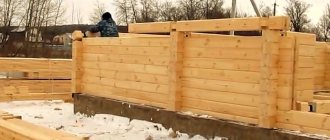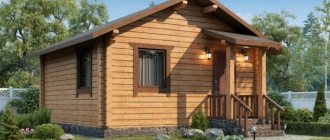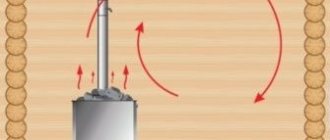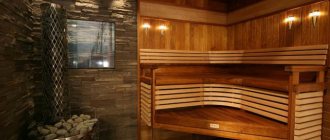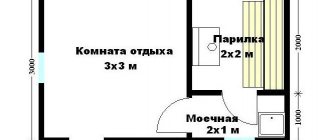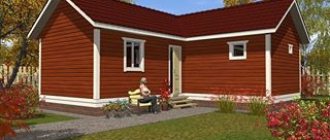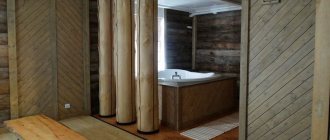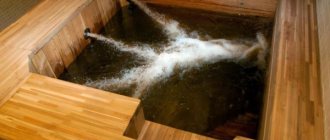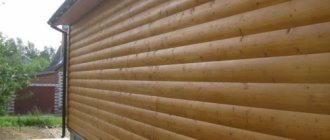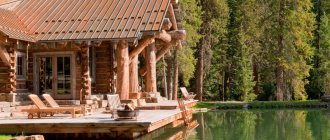Imitation of larch timber is a first-class finishing material that has an original appearance, color, strength and versatility in use. The use of this material will allow you to insulate your home or loggia from drafts, hide wall defects, and transform a bathhouse or sauna . Larch has a long service life and can be used under a wide variety of operating conditions for both internal and external wall decoration.
Material selection
For a steam room in a bathhouse, it is better to make the finishing from lining, for the manufacture of which various types of trees were used. Lining is an edged profiled board with grooves in it. It is quite often used for exterior and interior decoration.
This material is not only convenient and practical to use, but also has a number of advantages:
- Environmentally friendly and safe.
- Has a long service life. With proper care, it will last from 10 to 15 years.
- Depending on the chosen type of wood, it may have medicinal properties, so you can also focus on healing.
- Hypoallergenic.
- The structure of the material is optimal for finishing rooms with high levels of humidity, as it quickly absorbs and releases moisture.
- There is a huge selection of colors on sale. This makes it possible to choose the appropriate option and refuse to color the material, which can be harmful to human health.
- Availability.
Considering the available advantages of this material, most people prefer it.
Today on the market there is lining made from different types of trees. Therefore, before choosing one or another, it is necessary to study the characteristics and properties of each of them.
Lining for finishing a steam room can be made from the following tree species:
- Pine – its advantage is its low cost. At high temperatures, it releases resin, which is harmful to the human body. It is used for finishing steam rooms in which low-power electric heaters are installed.
- Cedar is a rather expensive but sought-after material. Cedar is a coniferous tree, but unlike pine it does not emit resin in large quantities. Has a pleasant smell.
- Birch is not the most suitable option for finishing baths. This is due to the fact that the material made from this tree is characterized by significant shrinkage.
- Larch – does not change its properties when in contact with moisture. It is distinguished by density and durability. Its porous structure does not change its properties during sudden temperature changes. The variety of shades of larch material and its natural shine make it popular for finishing baths. The disadvantage may be processing difficulties.
- Aspen is an affordable material that tolerates high temperatures quite well. It is resistant to moisture, so there is no need to worry about cracks. This wood is called a natural antiseptic, as it resists the formation of bacteria, fungi and mold on the surface.
- Alder is a relatively expensive material that is often used for lining a steam room. Its popularity is associated with its advantages - attractive appearance, good thermal insulation, unobtrusive, pleasant smell when heated.
- Linden is the best option for a steam room. It has attractive light shades. The peculiarity of this material is its slow heating, and this can protect bathhouse visitors from burns. The advantages include the fact that linden reacts well to moisture and practically does not deform. But linden is picky when it comes to care. Its absence will lead to the fact that after a year the lining will lose its presentable appearance.
- Oak is a strong and durable cladding. The disadvantages of oak are its cost and difficulties associated with processing.
In order to ensure quick heating of the room and to protect the walls from overheating, it is recommended to use lining made of deciduous trees. There is no need to skimp on material. After all, covering the steam room with clapboard is done for a long time.
Important! The most suitable tree species for the steam room are linden and alder.
Recently, most people use thermal wood to decorate the steam room in the bathhouse. This is a high-quality and environmentally friendly material, processed with hot steam (190–220 degrees).
The advantages of thermowood are:
- Low thermal conductivity.
- Improved hydroscopic properties - the material does not absorb moisture and does not rot.
- Characteristic brown-golden color.
- Lack of special care.
When choosing a material, you need to pay attention to its grade. For a steam room, it is better to use wood of the first or highest grade. This material is of high quality, there are no knots, nicks or irregularities on its surface, which means its service life will be long.
Differences in premises (rest room, washing room, steam room)
A national Russian bathhouse must have: a locker room (rest room), a steam room and a washing room. Of course, a kitchen, a swimming pool and a billiard room would not hurt, but these rooms are secondary. Each component of the bathhouse has its own unshakable rules: the floors in the washing room must not be slippery, the steam room must have microcirculation of air, and the relaxation room must absorb excess steam and water.
Steam room
Where to start finishing the inside of a bathhouse is from the steam room.
Lining is a good choice of materials - it will visually make the walls smoother, and the cladding method will give the room good air circulation, which will eliminate the appearance of condensation.
Installation will not be a problem. Not least important is the quality of the wood - only well-dried and sanded material is suitable for a bathhouse.
In a room where temperatures can reach 120 degrees Celsius, damp wood is not helpful.
Attention! Avoid stain, paint, varnish and other similar materials for finishing the inside of the bathhouse - at high temperatures, the coating will emit toxic substances, which will harm your health.
Washing
Here it is customary to take a break from the high temperatures by taking massages and body care products. That is, the most comfortable conditions are required. Therefore, the best material for the interior lining of a bathhouse will be ceramic tiles or coniferous wood, saturated with water-repellent resin, which will prevent the material from rotting. It is good to fill the floor of the washing room with concrete, and lay tiles or wooden beams on top.
Restroom
In the relaxation room, the body cools down, eats food and recovers from bath procedures. However, high air humidity does not go away, which needs to be leveled out. The interior decoration of a bathhouse made of timber made from deciduous and coniferous wood will help here. Natural stone, porcelain stoneware, majolica and decorative plaster will make the room beautiful and moisture-resistant.
Installation
A steam room covered with clapboard is beautiful, fast and inexpensive. This material provides a locking system (tenon and groove), thanks to which it will be possible to assemble all the parts in a short time, while the gaps will be minimal. The lining is attached to a wooden sheathing using self-tapping screws, nails or clamps.
In what sequence is the lining of a steam room in a bathhouse performed:
- Lathing. Non-planed boards and slabs are suitable for its installation. The sheathing will not be visible. The selected material is attached to the wall perpendicular to the direction of the lining (steps from 50 to 60 centimeters). The sheathing is fastened to a wall made of brick, concrete or stone using screws with plastic dowels, and to wooden walls - with galvanized self-tapping screws.
- Insulation . The optimal material for this would be basalt wool. Plates of wool are placed between the beams of the sheathing. It is necessary to ensure that no gaps are formed, otherwise the bath will not retain heat well.
- Vapor barrier . Its task is to prevent the accumulation of moisture in the insulation and reduce thermal conductivity. At this stage, strips of glassine or other material for vapor barrier are attached horizontally over the sheathing with insulation using a furniture stapler (from bottom to top). In this case, each subsequent strip should overlap (about 5 centimeters) with the previous one. All strips must be glued using adhesive tape or wide tape.
- Installation of lining . It is better to start attaching it from the most inaccessible corner.
Installation of the lining can be carried out in two ways:
- Vertical.
- Horizontally.
In the case of vertical fastening, you may encounter the appearance of fungus. It can be triggered by the fact that the board is heated unevenly. The temperature is higher at the top and lower at the bottom. In addition, the lower part suffers more from humidity.
Despite the above disadvantages, there is also a relative advantage - a low risk of gaps. The reason for this is the uniform deformation of all boards.
With horizontal installation, the risk of deformation of the lining is significantly lower. This is due to the fact that each board is located in a certain temperature zone. When installed horizontally, the upper boards experience greater shrinkage than the lower ones. This can lead to seams coming apart.
Steam and moisture protection
Finishing a wooden bathhouse is often impossible without insulating steam and moisture - these components provide a good microclimate, protecting the structure from moisture. To prevent the formation of fungus, mold, rot and other destructive factors, the structure is equipped with an insulation system from moisture and steam. From a design point of view, lining and other finishing materials make the room aesthetically pleasing, while moisture and steam tend to ruin all the beauty.
When starting interior decorating work, where to start is a simple question. After installing beacons on walls and floors, think about vapor barrier and waterproofing .
An additional heat-protective space is formed between the wall of the log house and the lining of the lining, which prevents heat from escaping, but provokes the appearance of condensation.
In addition, wood has minimal thermal conductivity, which creates a large temperature difference between the wall and the lining - steam penetrates into the joints of the lining, and when it reaches the wall it condenses, remaining on the walls of the log house. Over time, mold grows in the building and the wood rots.
Today, many materials are used for waterproofing and finishing wooden bathhouses, but not all are environmentally friendly. First, treat the sheathing and walls on the inside with an antiseptic to prevent mold and rot.
Next, materials that can withstand high temperatures will come in handy - mineral and glass wool are better suited than others. You can also purchase a more modern option - a waterproofing film, but for finishing bathhouses with wood this is not the cheapest pleasure. Insulating the walls under the lining is the right solution for waterproofing a room.
Floor waterproofing
Wall cladding when finishing a log bathhouse inside is best done after waterproofing the entire structure. Combine floor waterproofing materials with similar ones on the walls, which will provide maximum protection from moisture and steam. If the concrete floor in the bathhouse was made a long time ago, check its condition - the surface should be smooth and the concrete dry.
Important! After pouring, it takes 4 weeks for the concrete to dry completely, after which the floor must be treated with an antifungal solution, primer and coating waterproofing!
When the initial procedures for waterproofing the floor are completed, the floor is covered with rolled material and filled with screed. This is necessary both when covering the floor with wood and when finishing the inside of the bathhouse with tiles. Next, antiseptic plywood, OSB or board is laid over the waterproofing, and roofing felt is placed on top. This system is applied to the walls, connected with sealant or special tape. The joints on the floor are treated with mastic or the same sealant and the floor is equipped with a reinforced mesh and filled with concrete - screed. All that remains is to lay the outer cladding as the finishing touch to the flooring of the log bathhouse.
Important! It is advisable to carry out such extensive work on the bathhouse floor no earlier than a year and a half after the construction of the structure - after the final shrinkage of the log house.
Floor and ceiling finishing
The ceiling in the steam room can also be covered with clapboard. The same material option as for the walls is suitable for this. This will preserve the overall concept and give integrity to the steam room, creating a cozy atmosphere.
The floor in the steam room is the place that is least exposed to high temperatures. To set it up you need:
- Clay layer (concrete screed).
- Fiber zinc.
- Treated board or ceramic tiles.
Conclusion
In the video presented in this article you will find additional information on this topic. Also, based on the text presented above, we can draw conclusions that the selection of special equipment for a bathhouse must be approached very responsibly. It must meet all the requirements of a particular room and take into account its features (see also the article “Which location of the bathhouse on the site is correct”).
It should be noted that the concept of equipment itself can include almost all the elements and devices that make up a particular room and thanks to which it can function normally. Taking this into account, it can be understood that one cannot treat a structure such as a bathhouse separately. It must be considered as a whole and this is how all the necessary equipment must be selected.
Did you like the article? Subscribe to our Yandex.Zen channel
What should care be like?
It is not recommended to use painted boards for finishing the steam room. Also, they cannot be coated with varnish or stain. At high temperatures, such products will release harmful substances.
In order for the clapboard finishing of the steam room to please the eye for as long as possible, you need to properly care for it:
- Ventilate and allow to dry after each heating.
- Warm up the steam room to at least 70 degrees.
- In winter, cool the steam room to minus temperature.
It is recommended to periodically treat the steam room lining with oils. Both hemp, flaxseed and regular vegetable oil are suitable for this. They can be used pure or mixed with a few drops of essential oils. Using this method, it will be possible to polish the lining, give it shine and imbue it with an aroma, which will intensify at high temperatures.
If you properly care for the cladding and follow these recommendations, it will last for a long time. At the same time, it will not be spoiled by fungus or mold, and there will be no foreign odors in the bathhouse.
Important! Using oils to process the lining will allow it to remain clean for a long time.
Painting imitation timber
It is best to treat the finishing material on all sides at once, even before attaching it, using a special antiseptic. After all the work on installing the bathhouse using imitation timber is completed, it is necessary to additionally protect this coating using paint and varnish. Here, each of you has an unlimited choice, which in most cases is determined solely by the preferences of the bathhouse owner. How to cover the imitation panels depends only on you and your preferences.

